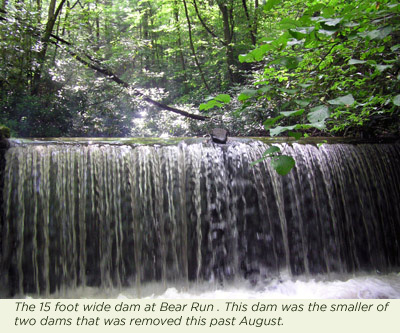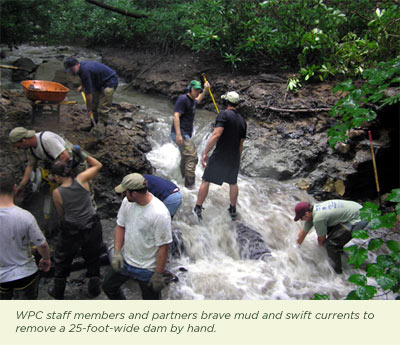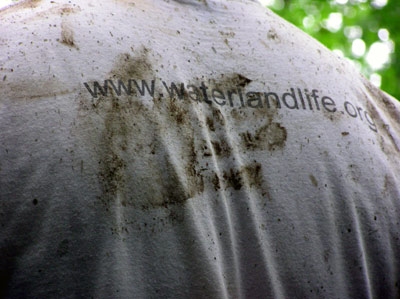
WPC and Partners Remove Dams by Hand
to Protect Surrounding Landscape
With an even mixture of mud, sweat and determination, WPC and its partners removed two large dams near the headwaters of Bear Run this past August. Their work returned the stream to its original state, liberated its celebrated brook trout population and improved the quality of the watershed. The removal marks the first time in the state’s history that dams of this size were removed by hand.
“The dams had really outlived their usefulness,” said Ben Wright, WPC’s assistant director of Freshwater Conservation. “They served no ecological purpose and impeded the spawning of brook trout.”

The partners in the project included the Pennsylvania Fish and Boat Commission, the Pennsylvania Department of Environmental Protection and American Rivers. Workers opted to employ elbow grease instead of dynamite in order to protect the surrounding environment.
Also, bringing in heavy equipment would have necessitated cutting an access road through a portion of WPC’s pristine 5,065-acre Bear Run Nature Reserve, which is home to
Fallingwater.
“It was really an issue of accessibility and not wanting to disturb a very peaceful and beautiful part of the world,” said Wright.
The two dams, one measuring 25 feet wide and 10 feet high, and the other measuring 15 feet wide and six feet high, were constructed in the late 1800s using rock, concrete and cinder blocks. The dams provided the Kaufmann family with a water source for their campground in the days preceding the construction of Fallingwater.
The project was completed in two and a half days rather than the projected five days because of the strong turnout. Eighteen people – including ten WPC staff members – hoisted pick axes, digging bars and sledgehammers to remove the dam stone by stone, while standing in the cold stream.

Pennsylvania Fish and Boat Commission biologist Dave Kristine said the dam’s removal will return the
stream to its free-flowing condition and allow uninterrupted passage of fish.
“The removals will also improve the habitat for macroinvertibrates by creating an environment that allows
these species to complete their life cycles,” Kristine said.
Macroinvertibrates are a primary food source for fish, which in the case of Bear Run is almost exclusively brook trout.
In the days preceding the dams’ removal, Pennsylvania Fish and Boat Commission staff members captured several brook trout residing within 1,000 feet of the dams and clipped asmall part of their tail fins in order to track the movement of the fish after the dam was removed.
“That’s how we typically mark fish,” said Kristine. “We’ll go back into that area and if we find the marked troutin the area above the former dam location, that’s a good indication that they are able to move freely.”
WPC received a $3,000 grant from American Rivers to help complete the dam removal project, which cost a little more than $7,000. A grant from the Pennsylvania Department of Environmental Protection funded the remainder of the project.

Winter 2008 Conserve | Western Pennsylvania Conservancy | Fallingwater